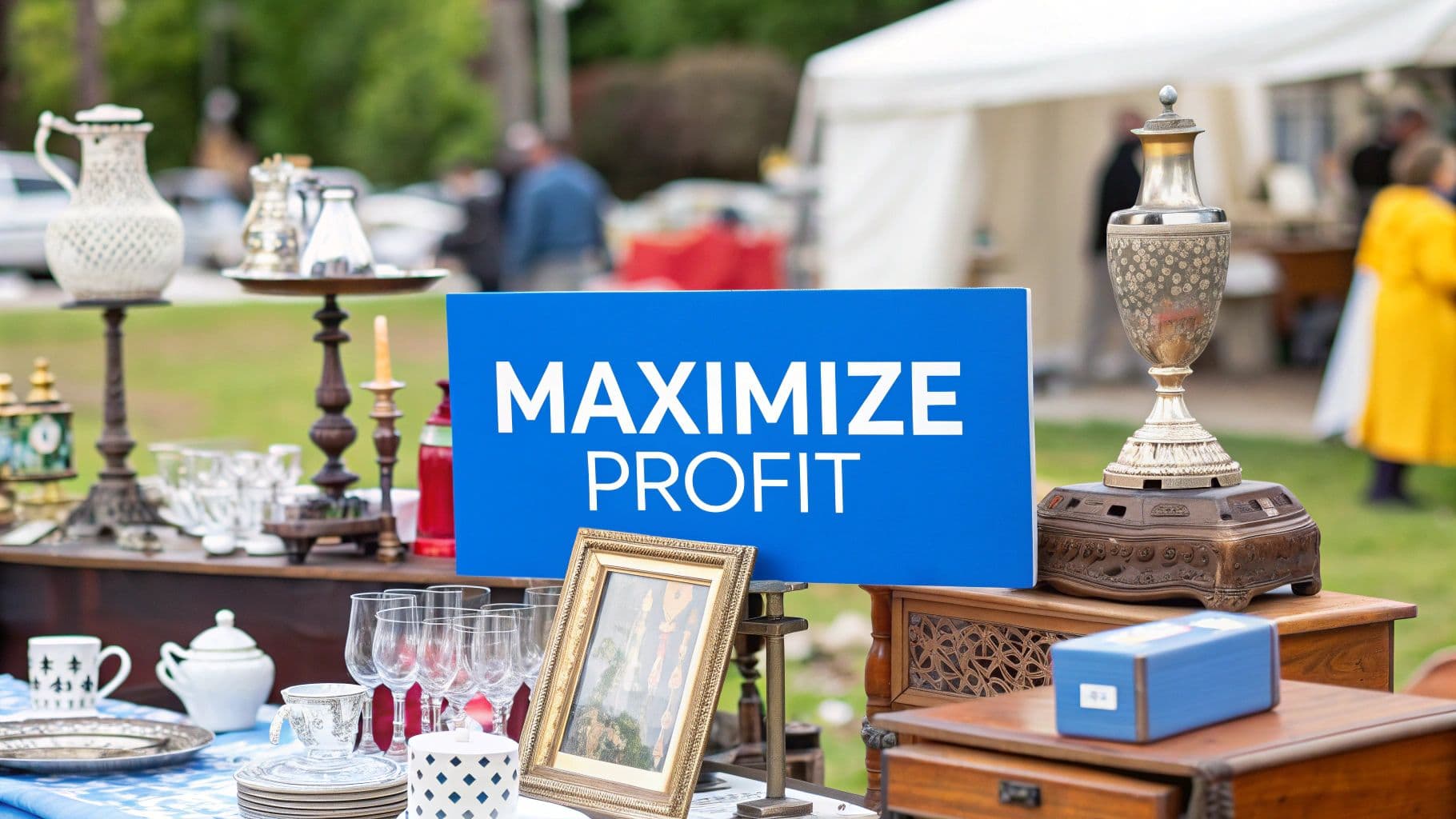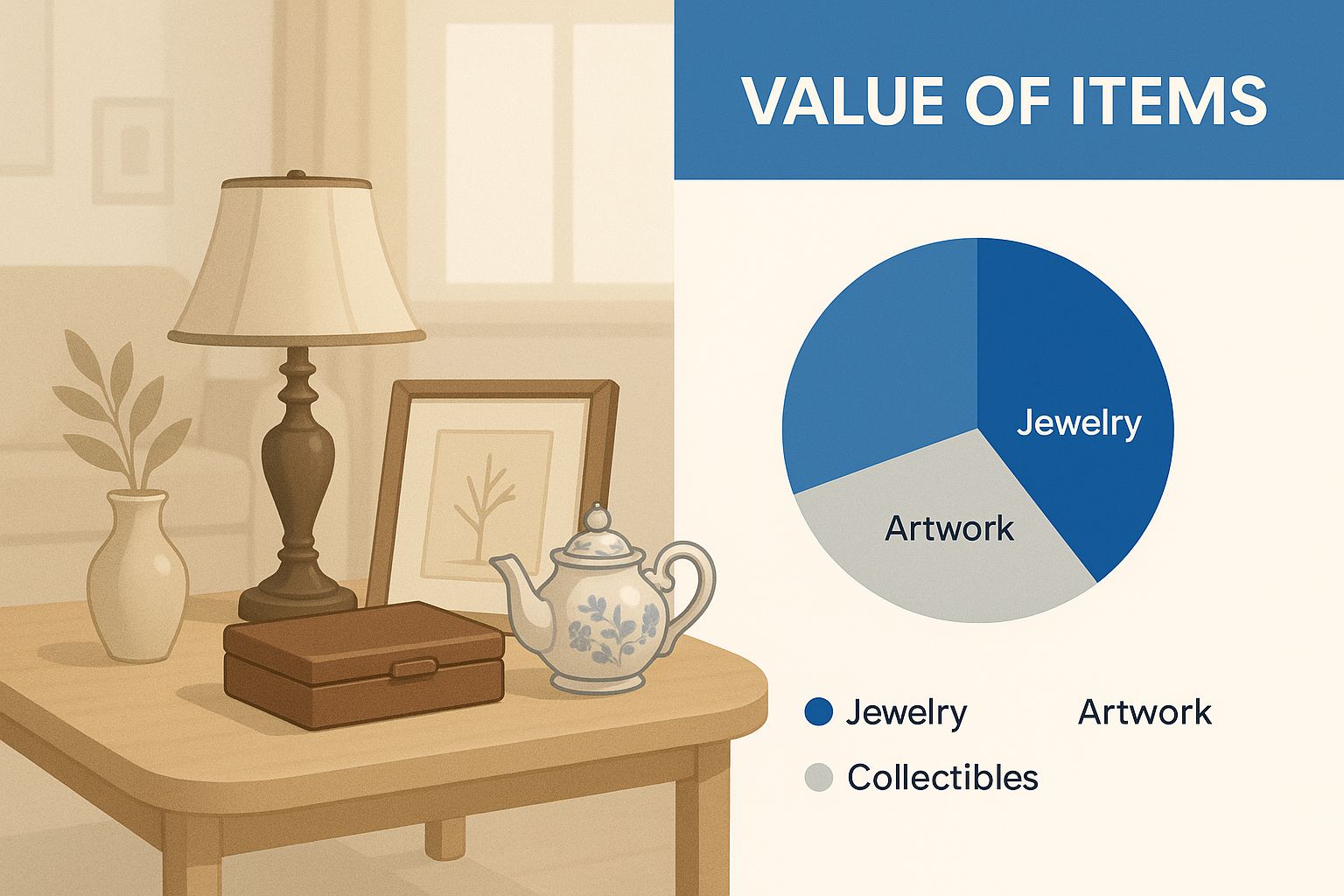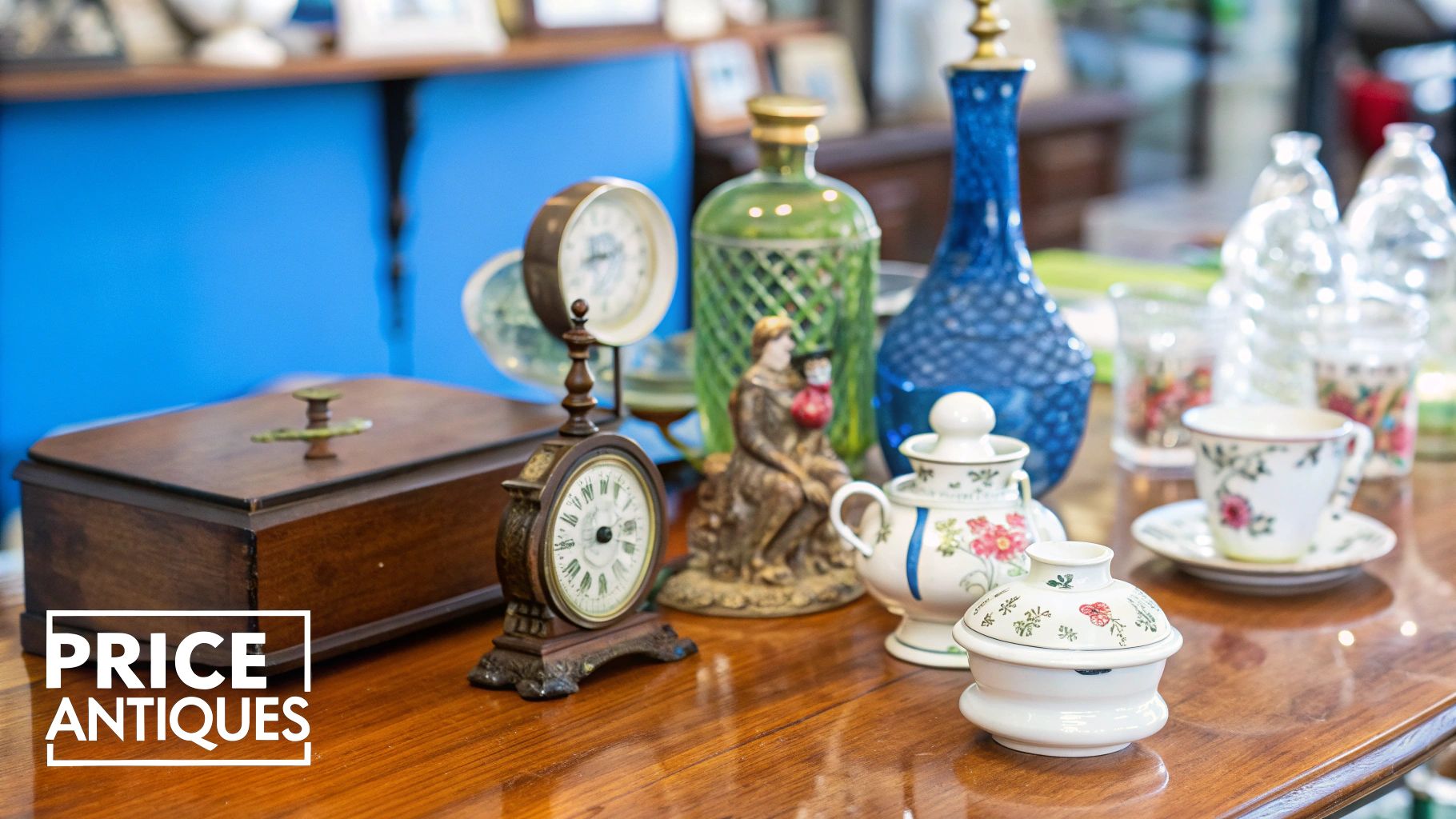Estate Sale Pricing Guide: Maximize Your Profit Today

When you're running an estate sale, your pricing strategy isn't just about putting numbers on tags. It's about adopting a specific liquidation mindset geared toward one primary goal: selling every single item within a 2-3 day window.
Success comes from understanding the huge gap between what an item cost new and what it’s actually worth in a secondhand setting. You have to price things to catch the eye of a bargain hunter, not what you’d see in a fancy retail shop.
The Foundation of Smart Estate Sale Pricing
Before you even think about pricing, you need to get your head in the right place. A lot of people new to this make the classic mistake of pricing items based on the original sticker price or, even worse, sentimental value. That approach is a surefire way to end up with a house full of stuff after the sale is over.
An estate sale isn’t a boutique. It’s a rapid-fire liquidation event. The main objective here is to clear the house completely.
This "liquidation mindset" is truly the most important thing to embrace. You aren't holding out for that one perfect buyer willing to pay top dollar. You're pricing for the dozens of shoppers who need to feel like they’ve found a deal worth their time and effort. Shifting your perspective this way helps you avoid the overpricing trap that scares away customers from the get-go.
Understanding Key Value Types
To price anything effectively, you have to know the difference between three distinct types of value. Mixing these up is a rookie mistake I see all the time.
- Retail Value: This is what an item sells for brand new in a store. For our purposes, this number is almost completely irrelevant.
- Fair Market Value (FMV): This is the magic number. It’s what a knowledgeable buyer is willing to pay a seller in a normal, unpressured situation. Think of it as the real-world secondhand price, which you can usually pinpoint by checking sold listings on sites like eBay.
- Liquidation Value: This is the price an item will realistically fetch under the tight deadline of an estate sale. It’s almost always a percentage of the FMV, set to create urgency and move merchandise quickly.
The goal is to find that sweet spot. You want to respect an item's Fair Market Value while still being aggressive enough for a quick liquidation. Your prices should make shoppers feel like they can't afford to walk away.
Adopting a Progressive Pricing Strategy
A static price list just doesn't work for an event that's over in a weekend. The most successful sales I've ever run or seen use a dynamic approach—what we call progressive pricing. This just means you start with fair, solid prices on day one and then roll out scheduled discounts on the following days.
A common model, for example, is to knock 25% off on day two and then slash prices to 50% off for the final few hours of the sale. This builds momentum and gives shoppers a reason to come back. They know if they wait, they might get a better deal, but they also risk losing the item to someone else.
Of course, a strategy like this only works if your inventory is well-organized from the start. For more on that, you can check out our comprehensive guide on how to organize an estate sale to make the whole process run smoothly.
This tiered discounting method is standard practice for the pros. In fact, many experts will initially price items at just 30-60% of their fair market value right out of the gate, adjusting based on the item's condition and what the local market will bear. This approach ensures you're not just selling items, but you're maximizing your revenue while still hitting that ultimate goal: clearing the house.
Conducting Smart Research for Accurate Valuations
Trying to put a price on a house full of someone's lifetime collections can feel overwhelming. I’ve been there. But a little bit of structured research is your best defense against just guessing. This is the absolute core of pricing things for an estate sale; it's what separates a successful sale from a frustrating one.
The goal here is to find the Fair Market Value (FMV). Simply put, that’s the real price a willing buyer recently paid for a similar item.
Before you even open your laptop, you need to burn one rule into your brain: look at sold prices, not asking prices. It’s a classic rookie mistake. Anyone can list a rusty floor lamp for $500 on Facebook Marketplace, but that price is pure fantasy until someone actually pays it. What people are actually paying is the only number that matters. This one distinction will keep your pricing grounded in reality.
Your Digital Toolkit for Item Valuation
The good news is that you have access to the same powerful resources that professional appraisers use every single day. The trick is just knowing where to look and what to look for.
A few key platforms will give you the historical sales data you need to get a realistic picture of an item's worth.
-
eBay's "Sold Items" Filter: This is your best friend for 90% of what you'll find in a house. After you search for an item, just scroll down the filter menu on the left and check the "Sold Items" box. Instantly, you’ll see what people have paid for everything from vintage Pyrex bowls to used power tools. It’s a fantastic baseline.
-
LiveAuctioneers & Invaluable: Now, for the finer things—art, serious antiques, high-end collectibles—you need to step up your game. These sites are databases for real-world auction houses. They show you the "hammer price" for items, which is essential for anything with a niche collector market.
By bouncing between these sources, you can build a solid, evidence-backed price for almost everything you come across.
Key Takeaway: Pricing shouldn't be a guess. It should be a conclusion you draw from real data. When you can point to actual sales, you have the confidence to stand firm on your prices when people try to haggle.
Here’s a quick-reference table to help you decide which tool is right for the job.
Valuation Tool Comparison for Estate Items
This table breaks down the most common online resources, helping you quickly choose the best platform for the item you're researching.
| Tool/Platform | Best For | Key Feature | Pricing Focus |
|---|---|---|---|
| eBay Sold Listings | Everyday household goods, collectibles, vintage clothing, tools | Real-time sales data from a massive public marketplace | Fair Market Value |
| WorthPoint | Antiques, obscure collectibles, branded decorative items | A vast archive of historical sales from eBay and auction houses | Historical FMV |
| LiveAuctioneers | Fine art, high-end furniture, jewelry, rare antiques | Aggregated results from professional auction houses | Auction Value |
Each tool gives you a different piece of the puzzle, so using them together gives you the most complete picture of an item's true market value.

Leveraging Advanced Research with WorthPoint
Sometimes, you need to dig a little deeper. For those situations, a subscription service like WorthPoint can be a game-changer. It pulls in sales records from tons of sources, not just eBay, creating a massive database that’s perfect for finding those oddball items.
The real power of WorthPoint is its ability to find prices for obscure or rare things that just don't show up in a regular eBay search. If you’re handling a serious collection, the subscription often pays for itself with just one or two discoveries.
Knowing When to Call a Professional Appraiser
Look, even with the best online tools, some things just need a specialist's eye. Your own research will get you through about 95% of a home's contents perfectly fine. But for a few high-stakes categories, calling in a professional appraiser isn't just a suggestion—it's essential for protecting the estate's value.
You absolutely should hire a certified appraiser for:
- Fine Art: An expert can verify the artist, provenance, and condition of paintings or sculptures in a way you simply can't online. This is where hidden fortunes are often found.
- Jewelry and Gemstones: You can’t accurately assess gem quality, metal purity, or designer craftsmanship without specialized tools and knowledge. A jeweler's appraisal is non-negotiable here.
- Rare Coins and Stamps: These markets are incredibly nuanced. The tiniest flaw or a specific mint mark can swing the value by thousands of dollars.
- Significant Antique Furniture: Sure, you can look up a brand like Drexel. But if you suspect you have a true 18th-century Chippendale piece, you need an expert to authenticate it. The difference in value is staggering.
Bringing in an appraiser for these key items prevents you from either giving away a masterpiece for pennies or trying to sell a fake for a fortune. It’s a targeted investment that ensures you get the maximum return on the estate's most valuable assets.
Your Category-by-Category Pricing Strategy

General pricing rules give you a decent starting point, but the real money is made when you understand the nuances of each category in a home. Let's be honest, a blanket "30% of retail" rule just doesn't cut it. The value of a Mid-Century Modern dresser and an antique silver spoon are driven by completely different market forces.
This breakdown gives you tangible starting points for the most common categories you'll face. Think of it as your field guide for turning household clutter into cash.
Pricing Furniture and Decor
Furniture is often the star of the show, but it can be tricky. Value really boils down to a mix of brand, style, and condition. A solid wood dresser from a known brand like Drexel or Ethan Allen, even if dated, has an inherent quality that commands a better price than a particleboard piece.
Style is a massive factor. Right now, Mid-Century Modern (MCM) and minimalist designs are in high demand. A sleek MCM credenza, even from a lesser-known maker, might sell for $200-$500. Meanwhile, a bulky, dark wood traditional china hutch could struggle to get $75. You have to factor in your local market's taste.
Condition is the final piece of the puzzle. Scratches, water rings, and torn upholstery will dramatically lower the price. A piece that's been well cared for can fetch 40-50% of its secondhand retail value, but a "project piece" needing work might only get 10-20%.
Pro Tip: Don't overlook the power of staging. A lamp placed on a side table or a vase on a bookshelf helps shoppers visualize items in their own homes. This small touch can justify a slightly higher price and encourage those impulse buys.
Valuing Kitchenware and Appliances
The kitchen is a treasure trove, but you need to know what you’re looking at. Most everyday glassware, plates, and pots should be bundled and priced to move. For example, a box of assorted drinking glasses might go for $5-$10, while a stack of mismatched plates could be $8.
But keep a sharp eye out for collectible brands. A single piece of vintage, colorful Le Creuset cookware can be worth $50-$100 or more, depending on its condition and color. Similarly, certain patterns of vintage Pyrex or CorningWare are highly sought after by collectors and should absolutely be priced individually after you research sold listings.
For small appliances like blenders or coffee makers, the rule is simple: if it's more than a few years old, price it low. A clean, working appliance might go for $10-$20, but don't expect much more.
How to Price Clothing and Accessories
Clothing is notoriously difficult to sell. Unless you've got a high-end designer label or a true vintage piece from the 1970s or earlier, it's best to price it to fly out the door. Think $1-$5 per item for most mall-brand clothing. Presenting it neatly on hangers is far more effective than dumping it in a box.
Here’s where you can find some hidden value:
- Vintage Clothing: A 1960s dress in good condition could be worth $30-$60. Look for unique patterns, metal zippers, and older union tags.
- Designer Handbags: Authentic bags from brands like Coach or Kate Spade can still fetch $25-$75, even with some wear.
- Costume Jewelry: Don't just toss it all in a bowl. Separate interesting pieces. Large, signed brooches or unique necklaces can sell for $5-$15 each.
Books, Tools, and Electronics
This grab-bag category requires a keen eye. Most paperback books are worth very little, so bundling them for $1-$2 a bag is a solid strategy. Hardcovers might get $1-$3 each. The big exception is a true first edition or a signed copy, which needs to be researched individually.
Tools are a consistent seller, especially power tools from brands like DeWalt or Makita. Price them at about 30-50% of their new cost if they are in good working order. Hand tools from top-tier brands like Snap-on also hold their value remarkably well.
Electronics, on the other hand, depreciate incredibly fast. A television that's over five years old might only be worth $20-$40. Old VCRs, DVD players, and stereo systems are often best priced at $5-$10 just to get them gone. The main exceptions are vintage audio equipment like turntables and receivers from the 1970s, which have a dedicated following.
For a deeper dive into the valuation process across all these categories, you can learn more about how to price estate sale items and really refine your approach. Mastering these category-specific strategies is a core part of building a successful and profitable sale.
How External Factors Impact Your Pricing
You can do all the item-level research in the world, but if you stop there, you're pricing in a bubble. The best estate sale professionals know that once the individual items are valued, it's time to zoom out and look at the bigger picture.
Several powerful forces outside the home's four walls can dramatically shift what shoppers will pay. Ignoring them is a recipe for a disappointing sale.
Think of your price tags as a conversation with your local community. A savvy seller knows how to listen to what the market is saying and adjust accordingly.
The Power of Geography and Local Tastes
Where you hold your sale matters—a lot. I’ve seen the exact same antique sideboard fetch double the price just a few towns over. It all comes down to local style and demand.
For instance, rustic farmhouse decor and primitive antiques might be incredibly hot in a rural or suburban area. Try to sell those same bulky pieces in a downtown city core full of small condos, and you’ll be practically giving them away on the final day.
You have to get a feel for the unique character of your sale's location.
- Scout the Local Retail Scene: Pop into nearby furniture and home decor shops. What are they selling? This is a direct line into current local trends.
- Be a Customer at Other Sales: Before your event, go to a few other estate sales in the area. Pay close attention to what sells fast and what’s still sitting there on Sunday afternoon.
- Know the Neighborhood: Is the area filled with young families needing practical furniture or a retirement community looking for specific collectibles? Your featured items and pricing should reflect that.
This kind of on-the-ground intel helps you highlight the right things and price them in a way that truly connects with the people walking through the door.
Reading Broader Economic and Market Trends
Looking beyond your immediate neighborhood, the wider economy always has a hand in shaping buyer behavior. When times are tight, shoppers are focused on value and practical goods. During an economic boom, you’ll see more people willing to splurge on high-end decor, art, and unique collectibles.
Global trade policies can also have a surprisingly direct impact on your sale. For example, recent tariffs have made many new imported goods more expensive, pushing more shoppers toward the secondhand market.
This shift has created a unique opportunity for estate sales. When new items are pricier or harder to find, smart shoppers and pro resellers flock to the secondary market. They're often looking for savings of 30–70% compared to retail.
This increased demand is a powerful lever you can use. Data shows that significant tariffs on imports have slowed the flow of new products into the country. As a result, estate sales are seeing bigger crowds and a lot more bulk buying from resellers who need to stock their own booths and online stores.
Understanding this dynamic should give you the confidence to hold firm on fair prices for in-demand items. You can learn more about how tariffs are shaping the estate sale industry and what that means for your bottom line.
The Impact of Seasonality and Weather
Finally, never underestimate the simple, practical effects of the calendar and the forecast. The time of year you hold your sale can directly influence who shows up and what they’re looking to buy.
Trying to sell a garage full of Christmas decor in July is an uphill battle. But hold that same sale in late October, and you could have a bidding war on your hands. Garden tools and patio furniture are hot tickets in the spring but get a lukewarm reception in the fall.
Even the weather on the day of the sale is a huge factor. A beautiful, sunny Saturday brings out droves of casual browsers. A cold, rainy day might keep everyone home except the most hardcore bargain hunters. You can't control the weather, but you can plan for it. If the forecast looks grim, be ready with a more aggressive discount strategy for the final day to make sure you still clear the house.
Staging and Tagging for Maximum Sales Impact

You’ve done the hard work of researching values and setting your prices. But the job isn't over yet. How you actually present and ticket your items is just as crucial to your bottom line as the prices themselves.
Think about it: a messy, poorly tagged sale creates a frustrating experience for shoppers. It can drive them away before they even lay eyes on your best items. Effective staging and tagging, on the other hand, transform a chaotic house into an inviting, shoppable space. This is where your research becomes a physical strategy that encourages browsing and, most importantly, boosts sales.
Creating a Boutique Experience
Your goal is to make the sale feel like a pop-up shop, not just a cluttered house. Shoppers are far more likely to spend time—and money—when the environment is clean, organized, and easy to get around in.
First things first: group similar items together. All the kitchenware goes in the kitchen, tools in the garage, and books on the bookshelves. This logical flow prevents confusion and helps buyers find what they’re looking for. Even better, it helps them discover things they didn't even know they wanted.
Whenever you can, place items in their natural setting. A beautiful china set should be displayed on the dining room table, not stuck in a dusty box in the basement. This kind of thoughtful staging elevates the merchandise and helps shoppers visualize it in their own homes.
The Psychology of Smart Bundling
Let’s be honest, not every single item is worth pricing individually. For low-value goods like mismatched coffee mugs, common paperback books, or a drawer full of kitchen utensils, bundling is your best friend. It’s a powerful tool that increases the perceived value while helping you clear out a ton of inventory quickly.
A single mug for $1 might sit there all day. But a box of six assorted mugs for $5 suddenly feels like a bargain and is way more likely to sell. The goal here is to move volume, and bundling is the fastest way to do it.
This strategy works wonders for categories that can feel overwhelming when presented as a sea of individual items.
- Kitchen Utensils: Bag up groups of spatulas, whisks, and measuring spoons for a single flat price.
- Linens: Fold and tie sets of napkins or hand towels together with a simple ribbon.
- Office Supplies: Grab a small box and fill it with pens, notepads, and paper clips.
Bundling essentially turns clutter into a marketable product. It’s a key piece of a truly successful pricing strategy.
Mastering the Art of the Price Tag
Clear, consistent, and easy-to-read price tags are completely non-negotiable. Confusion at the checkout is a sales killer, and a missing price tag often means a lost sale—most shoppers just won't bother to ask.
Your tags should be simple but informative. All you really need is the price and maybe a brief item description or inventory number if you're tracking sales that closely. Use pre-strung tags for items you can easily tie them to, and grab some low-tack painter's tape or removable stickers for delicate surfaces like book covers or finished wood.
Tagging Best Practices
- Visibility is Key: Place tags where they are immediately obvious. Don't make shoppers hunt for them.
- Avoid Damage: Never use strong adhesives on antique paper, photographs, or delicate fabrics. Seriously.
- Use Consistent Colors: Stick to one color for your main price tags. If you decide to run discounts on the second day, you can use a different colored sticker to show the new price. This makes it easy for both you and the customer to see the reduction at a glance.
This level of detail in your staging and tagging directly supports your pricing. It makes sure the value you've assigned to each item is clearly communicated to every single person who walks through the door.
Understanding the Financial Outcome of Your Sale
Once the last buyer has left and the dust settles, it’s time to crunch the numbers. This shift, from the emotional work of sorting through an estate to the practical task of reviewing the finances, is one of the most important parts of the whole process. Knowing what to expect financially from the get-go helps keep everyone grounded.
The total amount an estate sale brings in—the gross sales—can swing wildly. The final figure really depends on the quality and condition of the items, how sought-after certain pieces are, and even the location of the sale itself. A home packed with high-end, well-cared-for furniture will always do better than one with mostly worn-out, everyday goods.
Calculating Your Net Proceeds
If you go the route of hiring a professional estate sale company, their commission will be your single biggest expense. The industry standard fee hovers right around 35% of the gross sales. This covers their expertise in everything from pricing and staging to marketing and running the sale on the day.
So, if your sale grosses $10,000, the company will typically take $3,500, leaving the estate with a net payout of $6,500. For a deeper dive into these numbers, our article on average estate sale proceeds breaks it down even further.
It's easy to see that commission as just a cost. But it's better to view it as an investment. You're paying for professional expertise that almost always results in higher total sales and a much, much smoother process for the family.
So what does an "average" sale actually look like in dollars and cents? The good news is that the financial results have been trending up. A 2018 survey found the average U.S. estate sale pulled in roughly $18,565 in gross sales—a pretty big jump from years prior. After a typical 35% commission, that would leave the estate with just under $12,000. You can see the full report and estate sale financial findings on smartasset.com to get the complete picture.
Whether you decide to run the sale yourself or bring in a pro, getting familiar with these financial benchmarks is the only way to truly measure its success.